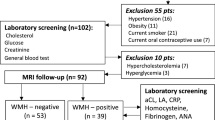Abstract
The aim was to evaluate whether patients with episodic migraine with (MA+) and without aura (MA−), during the interictal period of migraine would have an altered distensibility of the wall of cerebral arterial network and whether it would play a role in migraine headache. To evaluate the distensibility of the wall of cerebral arterial network, we measured the time-delay in milliseconds (ms) between the R-wave of an electrocardiogram and the arterial pulse wave of cerebral microcirculation (R-APWCMtd) on the frontal cortex detected by near-infrared spectroscopy (NIRS) in 10 patients with MA+ (age 39.5 ± 12.2 years), in 10 with MA− (age 40.3 ± 10.2 years), according to ICHD-3 criteria 2012, during the interictal period of migraine, and in 15 age-, sex- and height-matched healthy control subjects. The patients with migraine had a significantly longer R-APWCMtd than the control subjects F = 13.4, p < 0.001: MA+:+38.3 ms; MA−:+34.7 ms indicating an increased distensibility of the wall of cerebral arterial network. In multiple regression analysis, R-APWCMtd was significantly associated with migraine (R 2 = 0.50, p < 0.0001) but not with age, gender, height, migraine attack frequency and disease duration. The increased distensibility leads to an increased flow pulsatility into intracranial dural meningeal vessels that may lead to a mechanical stimulation of the nociceptors that innervate the dural vasculature. This condition may play a role in promoting the sensitization of trigeminovascular afferents and sterile inflammation within the dura mater that are fundamental to the pathogenesis of migraine headache.

Similar content being viewed by others
References
Bernstein Carolyn, Burstein Rami (2012) Sensitization of the trigeminovascular pathway: perspective and implications to migraine pathophysiology. J Clin Neurol 8:89–99
Wei X, Edelmayer RM, Yan J, Dussor G (2011) Activation of TRPV4 on dural afferents produces headache-related behavior in a preclinical rat model. Cephalalgia 31:1595–1600
Schillaci G, Sarchielli P, Corbelli I et al (2010) Aortic stiffness and pulse wave reflection in young subjects with migraine: a case–control study. Neurology 75:960–966
Mitchell GF, van Buchem MA, Sigurdsson S et al (2011) Arterial stiffness, pressure and flow pulsatility and brain structure and function: the age, gene/environment susceptibility—Reykjavik study. Brain 134:3398–3407
Viola S, Viola P, Litterio P, Buongarzone MP, Fiorelli L (2012) Correlation between the arterial pulse wave of the cerebral microcirculation and CBF during breath holding and hyperventilation in human. Clin Neurophysiol 123:1931–1936
Allen J (2007) Photoplethysmography and its application in clinical physiological measurement. Physiol Meas 28:R1–R39
Mackenzie IS, Wilkinson IB, Cockcroft JR (2002) Assessment of arterial stiffness in clinical practice. Quarterly J Med 95:67–74
Viola S, Viola P, Litterio P, Buongarzone MP, Fiorelli L (2013) A new near-infrared spectroscopy parameter as marker for patients with migraine. Neurol Sci 34(Suppl 1):S129–S131
Nichols W, O’Rourke M, Vlachopoulos C (2011) McDonald’s blood flow in arteries 6th edition: theoretical, experimental and clinical principles. Education book
Tarumi T, Shah F, Tanaka H, Haley AP (2011) Association between central elastic artery stiffness and cerebral perfusion in deep subcortical gray and white matter. Am J Hypertens 24:1108–1113
Borgdorff P, Tangelder GJ (2012) Migraine: possible role of shear-induced platelet aggregation with serotonin release. Headache 52:1298–1318
Shevel E (2011) The extracranial vascular theory of migraine—a great story confirmed by the facts. Headache 51:409–417
Burstein R, Jakubowski M (2005) Unitary hypothesis for multiple triggers of the pain and strain of migraine. J Comp Neurol 493:9–14
Davidoff Robert A (2002) Migraine: manifestations, pathogenesis, and management, 2nd edn. Oxford University Press, New York
Ashina M (2012) Vascular changes have a primary role in migraine. Cephalalgia 32:428–430
Conflict of interest
The authors certify that there is no actual or potential conflict of interest in relation to this article.
Author information
Authors and Affiliations
Corresponding author
Rights and permissions
About this article
Cite this article
Viola, S., Viola, P., Buongarzone, M.P. et al. The increased distensibility of the wall of cerebral arterial network may play a role in the pathogenic mechanism of migraine headache. Neurol Sci 35 (Suppl 1), 163–166 (2014). https://doi.org/10.1007/s10072-014-1761-1
Published:
Issue Date:
DOI: https://doi.org/10.1007/s10072-014-1761-1




